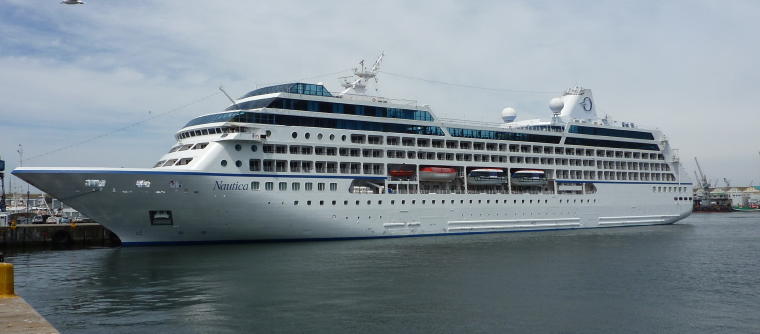|

Cape Town was settled by the Dutch in 1652. The Brits took it by
force in 1806. But there is still a lot of Dutch influence in the
city, including the language. English is the official language but
Afrikaans is a secondary language and is spoken by most of the people.
It is an original language created in South Africa. It based on
Dutch but also influenced by other nationalities including Indonesian
and Malasian. Cape Town is the second-most populous city in South
Africa with 5.7 million people, and the largest in land area. It
is the legislative capital of South Africa where the National parliament
and many government offices are located. The city is famous for
its harbor as well as such well known landmarks as Table Mountain
and Cape Point. It is hailed as one of the most beautiful cities
in the world by Forbes and is Africa's most popular tourist destinations.
The V & A Waterfront has been renovated and designed based on
the success of the wharfs in San Francisco and Sydney. There are
a myriad of restaurants, shops and street performers everywhere.
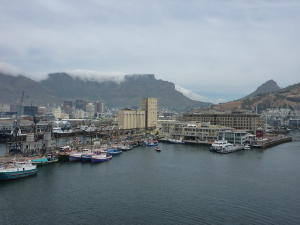 We
were supposed to be into port by noon but the fog was so thick that
they closed the harbor and the pilot boats could not come out to
us. So we sat for a while until it lifted enough to get in. Table
Mountain looms over Cape Town and we could still see the fog flowing
over the mountain. The locals call it "the Tablecloth". We
were supposed to be into port by noon but the fog was so thick that
they closed the harbor and the pilot boats could not come out to
us. So we sat for a while until it lifted enough to get in. Table
Mountain looms over Cape Town and we could still see the fog flowing
over the mountain. The locals call it "the Tablecloth".
When we were finally able to get into port, we had to hurry off
the ship to catch our tour to Robben Island. This is a 30 minute
ferry ride across from Cape Town. For over four centuries, Robben
Island has been a place of punishment for exiles and prisoners,
as well as a place of confinement for lepers, lunatics and the sick.
It is now a World Heritage Site due to the prison that was used
to hold political rebels during the apartheid era. This is where
Nelson Mandela was imprisoned. 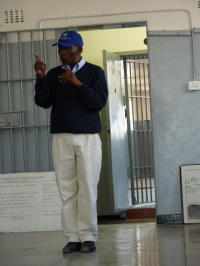 Our
guide was a former prisoner who gave a detailed description of conditions
in the prison. There were 18 men to a room (women were sent to a
different prison) and they slept on the concrete floor with no pillows
and a single blanket. The kind and amount of food was determined
by your race, but none of it was good. Many of the men were forced
to do backbreaking work in the limestone quarry where it was hot
and very bright, causing sun blindness in many. Our
guide was a former prisoner who gave a detailed description of conditions
in the prison. There were 18 men to a room (women were sent to a
different prison) and they slept on the concrete floor with no pillows
and a single blanket. The kind and amount of food was determined
by your race, but none of it was good. Many of the men were forced
to do backbreaking work in the limestone quarry where it was hot
and very bright, causing sun blindness in many. 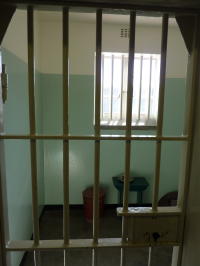 We
saw Mandela's cell and then took a bus tour of the island. In addition
to learning about the prison situation, we learned a lot about life
under apartheid and what is happening today in South Africa now
that it has been abolished. There are 3.5M people living in Cape
Town. 70% are Black, 20% Colored (this is anyone of mixed race and
a very acceptable term to use), and 10% are white. Since the end
of Apartheid in 1994, there are considerable initiatives to improve
the conditions of the Blacks. One of the laws is that any business
must hire according to the above ratio. Even if there are no qualified
Blacks for a certain job, it must be filled by a Black person. Consequently,
we saw a lot of seemingly excess people doing jobs like waiting
tables, porters, etc. in order to achieve the correct ratios. And
there are Blacks with management titles but they are often figureheads
with a White person doing double duty. And the Colored have been
ignored and not been given the extra initiatives like housing, etc.
But everyone we talked to were very optimistic about the direction
that things are moving. But they say it will take generations to
fix all the problems caused by Apartheid. The key is to get the
education systems in place to provide qualified people from all
the previously undereducated races. Bottom line, there's been progress
but there's still a ways to go. We
saw Mandela's cell and then took a bus tour of the island. In addition
to learning about the prison situation, we learned a lot about life
under apartheid and what is happening today in South Africa now
that it has been abolished. There are 3.5M people living in Cape
Town. 70% are Black, 20% Colored (this is anyone of mixed race and
a very acceptable term to use), and 10% are white. Since the end
of Apartheid in 1994, there are considerable initiatives to improve
the conditions of the Blacks. One of the laws is that any business
must hire according to the above ratio. Even if there are no qualified
Blacks for a certain job, it must be filled by a Black person. Consequently,
we saw a lot of seemingly excess people doing jobs like waiting
tables, porters, etc. in order to achieve the correct ratios. And
there are Blacks with management titles but they are often figureheads
with a White person doing double duty. And the Colored have been
ignored and not been given the extra initiatives like housing, etc.
But everyone we talked to were very optimistic about the direction
that things are moving. But they say it will take generations to
fix all the problems caused by Apartheid. The key is to get the
education systems in place to provide qualified people from all
the previously undereducated races. Bottom line, there's been progress
but there's still a ways to go.
This was our last night aboard the Nautica. The next day we were
off the ship by 8am and met by our driver who took us to the Sanbona
Reserve for our 3 day Safari. To learn about our Safari, go to Safari
Newsletter. To see photos from the Safari, go to Safari
Photo Gallery.
Following our stay at Sanbona, we were picked up for the drive
back to Cape Town. 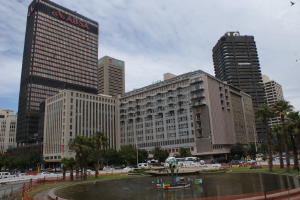 We
checked into the Fountains Hotel in the center of the downtown area.
We were given a penthouse suite, complete with kitchen, two bedrooms
and baths and a huge balcony overlooking Table Mountain. Unfortunately,
it was so windy that the room was too noisy to be able to sleep.
Between the howling wind and the rattling doors and vents, there
was no way we could get a good night's sleep. So we asked for a
different room and got a much smaller, but quiet one. We
checked into the Fountains Hotel in the center of the downtown area.
We were given a penthouse suite, complete with kitchen, two bedrooms
and baths and a huge balcony overlooking Table Mountain. Unfortunately,
it was so windy that the room was too noisy to be able to sleep.
Between the howling wind and the rattling doors and vents, there
was no way we could get a good night's sleep. So we asked for a
different room and got a much smaller, but quiet one.
The following day we took an all day tour of the Cape Peninsula
with Africa Eagles Tours.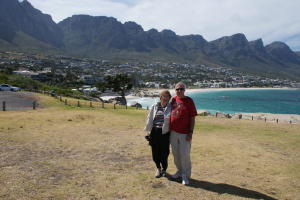 The tour went along the coast south of the city. The towns on the
coast have beautiful white sand beaches and houses/apartments built
into the cliffs. This is where the rich and famous have homes.
The tour went along the coast south of the city. The towns on the
coast have beautiful white sand beaches and houses/apartments built
into the cliffs. This is where the rich and famous have homes.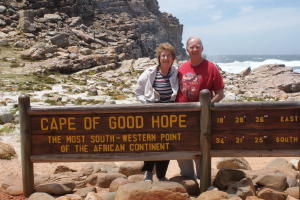 We
visited the Cape of Good Hope in Table Mountain National Park. This
is the most south westerly point of Africa. It is also the junction
of two of the earth's most contrasting water masses - the cold Benguela
current on the West Coast and the warm Agulhas current on the East
Coast. Many ships have been wrecked trying to sail around this point.
Today it was so windy that two of the people with us were actually
blown over while we were taking pictures. We learned that Cape Town
is often windy in the summer. The locals call it the "Cape
Doctor" because it blows all the pollution out to sea. We
visited the Cape of Good Hope in Table Mountain National Park. This
is the most south westerly point of Africa. It is also the junction
of two of the earth's most contrasting water masses - the cold Benguela
current on the West Coast and the warm Agulhas current on the East
Coast. Many ships have been wrecked trying to sail around this point.
Today it was so windy that two of the people with us were actually
blown over while we were taking pictures. We learned that Cape Town
is often windy in the summer. The locals call it the "Cape
Doctor" because it blows all the pollution out to sea.
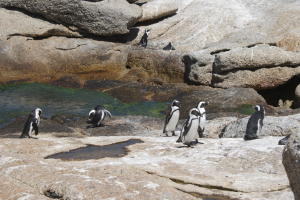 We
continued on to Cape Point for lunch. Then drove up the other side
of the peninsula, stopping at a beach where African Penguins nest.
These are an endangered species also called Jackass Penguins due
to the braying sound they make. They are similar to the Magellanic
Penguins we saw in Antarctica. We
continued on to Cape Point for lunch. Then drove up the other side
of the peninsula, stopping at a beach where African Penguins nest.
These are an endangered species also called Jackass Penguins due
to the braying sound they make. They are similar to the Magellanic
Penguins we saw in Antarctica.
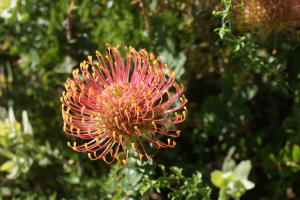 Our
last stop was the Kistenboch National Botanical Gardens. This is
a beautiful government owned park established in 1913, the first
indiginous botanical garden in the world. With 528 hectares, it
contains more than 4500 species of plants and trees, many rare or
endangered, as well as beautiful sculptures throughout. It is part
of the Cape Floristic Region which has been designated a World Heritage
Site - the only Botanical Garden to have this designation. It would
take several days to see the whole thing and we only had 1-1/2 hours!
But we made the most of it and Fred has many pictures to prove it. Our
last stop was the Kistenboch National Botanical Gardens. This is
a beautiful government owned park established in 1913, the first
indiginous botanical garden in the world. With 528 hectares, it
contains more than 4500 species of plants and trees, many rare or
endangered, as well as beautiful sculptures throughout. It is part
of the Cape Floristic Region which has been designated a World Heritage
Site - the only Botanical Garden to have this designation. It would
take several days to see the whole thing and we only had 1-1/2 hours!
But we made the most of it and Fred has many pictures to prove it.
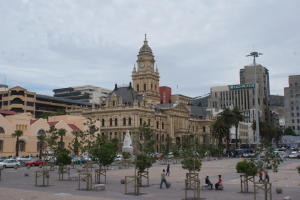 For
our last day in Cape Town we decided to take the Hop-on, Hop-off
bus tour. This takes about 2 hours if you stay on but you can get
off at any of the 15 stops and get back on again. We were given
ear buds that plugged into a receptacle next to each seat. You can
select any of the languages to hear the narration. We stayed on
through the whole tour of the downtown area but there were several
museums along the way that would have been interesting to visit. For
our last day in Cape Town we decided to take the Hop-on, Hop-off
bus tour. This takes about 2 hours if you stay on but you can get
off at any of the 15 stops and get back on again. We were given
ear buds that plugged into a receptacle next to each seat. You can
select any of the languages to hear the narration. We stayed on
through the whole tour of the downtown area but there were several
museums along the way that would have been interesting to visit.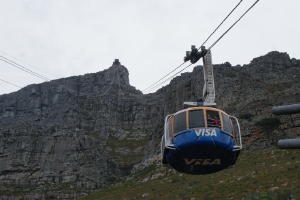 However, this was the first non-windy day since we had come to Cape
Town and the cable car up Table Mountain was finally open so we
decided to make that our first stop. Table Mountain towers over
Cape Town and can be seen from everywhere in the city. It is often
covered in clouds due to the winds coming off the ocean carrying
the moisture over the top of the mountain. The locals call it the
"Tablecloth" because of the way it rolls down the side.
Today it was clear. The tram to the top carries about 65 people
at a time and the floor rotates as it climbs so that everyone gets
to see the views.
However, this was the first non-windy day since we had come to Cape
Town and the cable car up Table Mountain was finally open so we
decided to make that our first stop. Table Mountain towers over
Cape Town and can be seen from everywhere in the city. It is often
covered in clouds due to the winds coming off the ocean carrying
the moisture over the top of the mountain. The locals call it the
"Tablecloth" because of the way it rolls down the side.
Today it was clear. The tram to the top carries about 65 people
at a time and the floor rotates as it climbs so that everyone gets
to see the views.  At
the top, there are many paths to spectacular views in all directions.
Table Mountain National Park is part of the Cape Floristic Region
and has over 1400 different species of plants. At
the top, there are many paths to spectacular views in all directions.
Table Mountain National Park is part of the Cape Floristic Region
and has over 1400 different species of plants.
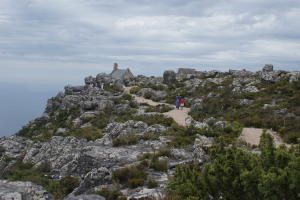
Back on the bus, we headed up the coast and on to the harbor area.
After lunch and a little shopping, we got back on the bus to return
to the hotel to wait for our transportation to the airport for the
long flight home (12 hours to London, then 12 more hours to Los
Angeles!)
Cape Town is a beautiful city and we would love to come back and
spend even more time here. Of all the ports on our cruise, this
was by far our favorite.
To view more photos from Cape Town, please go to Cape
Town Photo Gallery. To read about our safari in Sanbona Game
Reserve, go to Safari Newsletter.
Home
Locations Visited Photos Map
Contact Us
|
